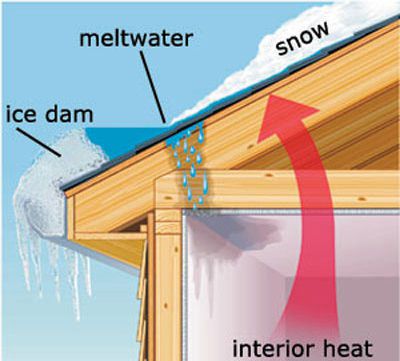
An Ice Dam is when a barrier of ice, blocks melting snow from draining off a home’s roof. Literally creating a dam of ice on top of your house.
Step by Step Breakdown Of An Ice Dam:
1. Heat Rises From Inside the home
Due to the cold weather that winter brings, you’ll most likely be heating your home up. As heat rises from inside the home, it will inevitably seep into the attic causing the roof deck to get warmer while warming up the snow that is layered onto the roof.
2. Melted Snow Flows down the lower roof edge and Freezes
As the snow gradually melts on the top of your roof, it’ll naturally flow (if the roof is pitched) downward to the edge of the roof. The edge of the roof will be cooler in temperature than the center of the home which will then cause the previously melted snow water to refreeze again- hence the dam.
3. Additional Snow Melts, Causing More Issues
The dam will continue to grow as it is fed by the melting snow above it. Limiting itself to the areas of the roof that average below 32 degrees Fahrenheit. With the fluctuating winter temperatures, usually additional snow will melt that will add to the ice damage.
4. As the Ice melts, its can damage the home
The pools of melted snow can expand their way up under the roof protection as well as the ice under the roofing shingles are cause for concern. Paired together with the constantly thawing/freezing ice, there can be exponential damage caused to the home.

In Order To Prevent Ice Damming, A Properly Installed Ice Shield Can Make A huge Difference.
To be completely transparent, there is no 100% foolproof way to prevent Ice damming from happening to your home, however; having a properly installed ice shield put on when the roof is being installed can certainly lessen the home owners risk of ice damming. If you haven’t heard of an ice and water shield, it is a protecting waterproof underlayment membrane that was intentionally developed to protect vulnerable areas on a roof from ice and water damage.
Another suggestion to prevent ice damming from happening to you, is to make the ceiling air tight, so that no warm or moist air can flow from the house into the attic space. Once you have sealed air leakage pathways between the house and attic, it could be a good idea to also increase the ceiling roof insulation in order to cut down on heat loss by conduction.
If you have any other questions, Bolingbrook Promar Roofing is happy to talk. With over two decades of direct roof experience serving our community, we hope you trust our expertise. Click Here for a free roof quote.
